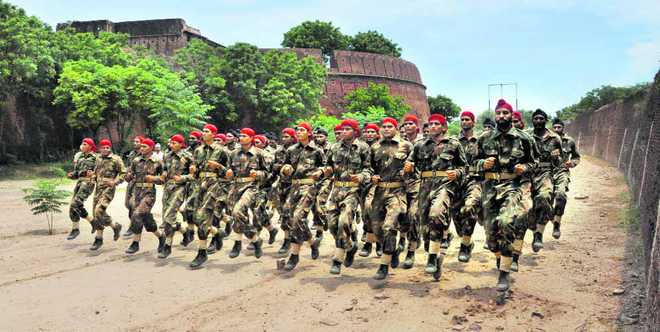Amid the ruins of 400-year-old Bahadurgarh Fort, a platoon of Punjab police Commandoes is busy training how to save lives. Strenuous exercises, the summer sun at noon and the humid season form a villainous cocktail. As the two-hour hand-to-hand combat session comes to a close, the 25 men are on the verge of their breaking point. The trainer sounds a whistle to mark the end of the session and orders them to fall in: their real test of fitness and agility starts now. The trainer orders 20 pushups.
“Commando, move ahead,” is the command from the trainer spoken in Punjabi or Hindi with an accent. “It exhorts them on and on, taking one step at a time, in training and in operation,” says the trainer.
The fort is inspiring: it literally means the place of the brave (bahadur). The fort is named after the Sikh guru, Guru Tegh Bahadur, who spent some time here while on his way to Delhi where he sacrificed his life to prevent forcible conversion of Kashmiri Pandits. A mosque built in memory of Saif Khan, the fort keeper, is preserved inside the precincts. There is also a temple and a gurdwara.
In another corner of the 52-acre greenery within the fort, the Commando Training Centre also has a group of women constables from Punjab Police, quietly engrossed in understanding different types of explosives. Meanwhile, deafening sounds of gunshots fill the air. With nearly 1,000 trainees attending various sessions every day during their three-month training schedule, the firing continues intermittently all day. Post-Dinanagar and Pathankot terror attacks, special night training sessions are also held.
Gurpreet Singh, commandant, says specialized training includes shooting at multiple targets while running. It also includes lobbing hand grenades and how to prevent injury to yourself and the fellow commandos. “The commando is trained to kill the enemy and save lives of countrymen, shrug off the dust and return to the base safely. He is not trained to become a martyr,” says a trainer.
There is huge stress on building a cohesive unit. The trainees are shown relevant movies and documentaries while seniors share their experiences. Psychologists from Punjabi University or from other parts of the state are also called in to strengthen the motivation levels.
Says IG -Training Rakesh Chandra, “A trainee sleeps as a commando, wakes up as a commando and thinks like a commando. He is mentally agile and physically fit, anywhere, with or without weapons.”
The Police Commando Training School was established in 1989 to raise a force against terrorists. Police teams from other states also train here,” says Gurpreet Singh, commandant.
A day at the training school starts at 5 am with 40 minutes of jogging and exercises followed by strength building exercises. After a break from 8 am to 9 am, the group reassembles in battle fatigues for unarmed combat and weapons tactics training till 12:30pm. A trainee is taught how to assemble a weapon, repair it and shoot a target from different angles and distance. At 3 pm, it is again time for hand-to-hand combat, obstacles course, ambush learning and the jungle warfare exercise.
“For any commando training, the basic courses are the same: enhancing stamina, resistance and mental endurance. After Dinanagar terror attack on a police station, we have included modules of fighting the enemy in a crowded civilian area. This includes jumping off a building without hurting oneself,” said the Commandant.
“When you wear uniform you are filled with new energy. The fatigue vanishes. You feel like a superhuman,” says a Sikh youth. There is a small gap: Once the course is over, the daily practice suffers, “Back in active duty, this routine cannot be followed. Even the morning physical exercises are not held in district headquarters. A commando in them must not die,” said a senior officer.
Unlock Exclusive Insights with The Tribune Premium
Take your experience further with Premium access.
Thought-provoking Opinions, Expert Analysis, In-depth Insights and other Member Only Benefits
Already a Member? Sign In Now










